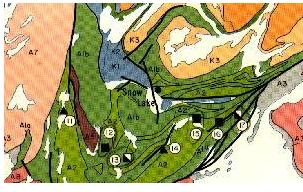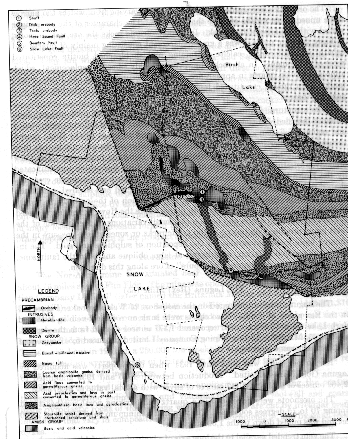Mining in Manitoba
Geology of the Snow Lake Area
GEOLOGY
 |
Precambrian rocks, which underlie the area, are boredered on the south by Ordovician dolomite. The Precambrian rocks may be divided into 4 main groups. Probably the oldest group comprises mafic and felsic lava flows with associated intrusions and beds of tuff, volcanic breccia and agglomerate. This group is correlated with the Amisk group of the Flin Flon area. |
The second group consists mainly of conglomerate, arkose, greywacke interbedded thin slaty members, and minor schists. The third group, known as the 'Kisseynew gneiss, is widespread in the northern part of the area. It consists chiefly of highly metamorphosed sedimentary material; garnetiferous gneisses and schists, staurolite-sillimanite gneisses and schists, feldspathic sedimentary rocks, minor mafic pyroclastic rocks, mafic lavas, and gneisses derived from arkose. The fourth group of rocks is intrusive and consists of predominantly granitic rocks of various ages but the batholitic bodies appear to be generally younger than any volcanic and sedimentary rocks in the area.
The general trends of folded structures in the area is N and NE. Folds plunge south in the File Lake area and west of there, and generally north in the Snow Lake area. East of Wekusko Lake sets of doubly plunging synclines and anticlines trend NE. The entire structure possibly due to folding and subsequent deformation caused by the southward thrust along the Kisseynew lineament. Faults and shear zones are numerous.
MOst of the deposits are quartz veins that occur along shear zones in lavas and that locally cross dykes of fine-grained quartz diorite, dacite porphyry, and quartz feldspar porphyry cutting across the greenstones. The shear zones either cross the structure at various angles or follow the regional cleavage of the rocks.
On broad mineralogical grounds, the deposits can be divided into 4 main groups:
- those in which pyrrhotite is the most abundant sulphide
- those in which pyrite is the most abundant
- those that contain amounts of galena and sphalerite
- those in which arsenopyrite is the main sulphide
Nearly all of the pyrrhotite-rich deposits carry some chalcopyrite and some nickel. Numerous sulphide deposits near Snow Lake are marked on the surface by extensive gossan zones from which gold can be panned, but the underlying solid rock yields only small amounts of gold.

The ore deposits are tabular to lenticular and vary from 4 to 10 feet wide and from 200 to 1800 feet long; the known depths vary from 300 to 1200 feet. Unlike the Flin Flon deposits which occur in typical Precambrian 'greenstone', most of the Snow Lake sulphide deposits occur in gneisses and schists. As well, Snow Lake deposits appear to lack well-defined structural control.